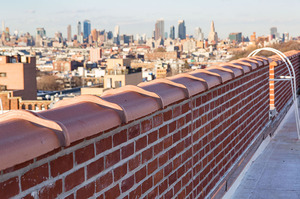 Parapets in New York City must be inspected annually per Local Law 126 of 2021.
Parapets in New York City must be inspected annually per Local Law 126 of 2021.
Parapets Must Now Be Inspected Annually in NYC
New York City building owners are subject to a new regulation, starting January 1, 2024, which mandates annual parapet inspections. The rule requires owners of buildings with parapets fronting the public right-of-way to comply. Here's all the essential information owners need to know to meet this new requirement.
Who is Affected?
This rule is applicable to all buildings located within New York City, regardless of their height, as long as they have parapets that are visible from the public right-of-way. However, detached 1- or 2-family homes and buildings equipped with barriers that prevent public access to the exterior wall are exempt from this requirement.
An exterior wall is considered part of the public right-of-way if any member of the public, unaffiliated with the property, can freely approach and access the building's facade, even if that exterior wall is situated on private property.
Additionally, buildings with a continuous barrier located within a perpendicular distance from the exterior wall, equal to or less than half the height of the exterior wall, must undergo inspection in accordance with this rule.
Who Can Perform the Inspection?
To comply with the rule, building owners must hire a qualified professional or an individual capable of identifying hazards on the parapet. Those qualified to perform these inspections include, but are not limited to: bricklayers, building superintendents, handymen, masons, architects, engineers, inspectors from New York State-authorized insurance companies, New York State-authorized building inspectors, and individuals with relevant expertise.
Inspection Criteria
The parapet inspections must be thorough, encompassing close-up examinations of the entire parapet, which can be conducted by boom trucks, scaffolds, and other methods for cornices. They can also be conducted from a fire escape or the roof. The inspection should include, but is not limited to, the following:
- Ensuring the parapet is plumb by a horizontal distance within one-eighth of its cross-sectional thickness at any location.
- Assessing for excessive deterioration, which includes displacement, cracks (horizontal or diagonal), missing or loose bricks or coping stones, deteriorated mortar joints, spalling, or rot.
- Verifying the stability of appurtenances, such as telecommunications equipment, railings, roof access rails, gooseneck ladders, handrail attachments for fire escapes, and signs.
Cornices: Cornices that are attached to the front wall or roof without a parapet behind them are exempt from inspection. However, cornices attached to parapet walls are subject to annual inspections as they are classified as appurtenances.
Download our Parapet Inspection Checklist. Note: This Parapet Inspection Checklist is provided as a general informational guideline only for conducting inspections in accordance with local regulations. Whereas it covers essential aspects of parapet safety, it is not an exhaustive list, and unique building conditions or parapet characteristics not listed may require inspection. Building owners are advised to exercise judgment and seek professional advice when necessary for a comprehensive assessment.
Dealing with Hazardous Conditions
In cases where the parapet inspection reveals a hazardous or unsafe condition, swift action is required:
- The individual conducting the inspection must immediately notify the Department of Buildings by calling 311 and emailing parapets@buildings.nyc.gov.
- The building owner must promptly install public protection measures, such as erecting sidewalk sheds, fences, or safety netting, to ensure public safety.
- All hazardous conditions must be remedied within ninety (90) days from the notification to the Department, with the public protection measures remaining in place until the issue is fully resolved.
If a building is subject to FISP (Facade Inspection Safety Program) filing an Unsafe Notification (FISP3) in DOB NOW Safety is also required.
Reporting Requirements
Building owners must prepare detailed reports of the parapet inspection, which must, in the following order and sequence, include but is not limited to:
- Building address and any associated addresses.
- Owner's name, mailing address, telephone number, or, if the owner is an entity, the principal's name, mailing address, telephone number, and position/title.
- The name of the person who conducted the inspection, along with their contact information and affiliation with the building or owner.
- Date(s) of the inspection.
- A location plan of the parapet(s) observed.
- Parapet construction details, including materials, height, and thickness.
- General conditions observed, any unsafe conditions or conditions requiring maintenance found, and actions that must be taken to address them.
- Documentation of any repairs made to the parapet since the previous report.
- Dated photos documenting the parapet's condition at the time of inspection.
The observation report must state if the parapet is unsafe, safe or requires maintenance.
In the year when a building is subject to the FISP and submits a FISP report, it may serve as the observation report for the parapet inspection rule, provided that it contains all the information required. The owner must maintain a copy of the FISP report for availability upon request.
When Is the Deadline for Conducting Parapet Inspections?
Parapet inspections must be completed and an observation report kept on file by December 31 of each year.
Maintaining Records
Owners are required to maintain these observation reports for at least six (6) years and must make them available to the Department of Buildings upon request. While the inspection reports are not mandated to be filed, building owners are strongly encouraged to treat this requirement seriously and consider assistance from qualified professionals as needed to fulfill their obligations under this rule. This regulation, designed to enhance public safety and maintain the structural integrity of buildings, is a critical step toward safeguarding both properties and public safety.
Contact RAND
If you have any questions or require guidance regarding parapet wall inspections, or structural or building envelope concerns, or if you would like to schedule an inspection, contact RAND at 212-675-8844 or info@randpc.com.
